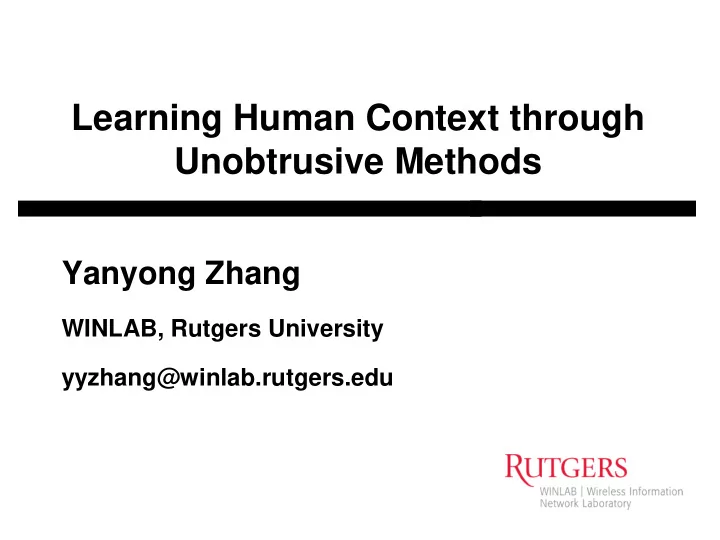

Learning Human Context through Unobtrusive Methods Yanyong Zhang WINLAB, Rutgers University yyzhang@winlab.rutgers.edu
We care about our contexts Meeting Vigo: your first energy meter Glass Necklace Fitbit: Get Fit, Sleep Better, All in the one Wristband Watch Phone Fall detection for the elderly Yanyong Zhang yyzhang@winlab.rutgers.edu 2
But, Can we learn contexts in an unobtrusive manner? No need to wear a device No need to report status No extensive calibration It naturally takes place as we live our life Yanyong Zhang yyzhang@winlab.rutgers.edu 3
SCPL Radio-frequency (RF) based device-free localization: location, trajectory, speed [1] C. Xu, B. Firner, Y. Zhang, R. Howard, J. Li, and X. Lin. Improving rf-based device-free passive localization in cluttered indoor environments through probabilistic classification methods, In ACM/IEEE IPSN, 2012. [2] C. Xu, B. Firner, R.S. Moore, Y. Zhang, W. Trappe, R. Howard, F. Zhang, and N. An. Scpl: indoor device-free multi-subject counting and localization using radio signal strength. In ACM/IEEE IPSN, 2013. Yanyong Zhang yyzhang@winlab.rutgers.edu 5
Device Free Passive Localization Empty room Yanyong Zhang yyzhang@winlab.rutgers.edu 6
DfP Localization Geometry to the Rescue? Yanyong Zhang yyzhang@winlab.rutgers.edu 7
No! Because of Multi-path effect Empty room Yanyong Zhang yyzhang@winlab.rutgers.edu 8
Fingerprinting Yanyong Zhang yyzhang@winlab.rutgers.edu 9
Cell-based Fingerprinting Link 2 RSS (dBm) k = 1 k = 2 k = 3 Link 1 RSS (dBm) Yanyong Zhang yyzhang@winlab.rutgers.edu 10
Linear Discriminant Analysis RSS measurements with person’s presence in each cell is treated as a class/state k Each class k is Multivariate Gaussian with common covariance Link 2 RSS (dBm) k = 1 Linear discriminant function: k = 2 k = 3 Link 1 RSS (dBm) Yanyong Zhang yyzhang@winlab.rutgers.edu 12
Evaluation Platform Hardware: PIP tag Microprocessor: C8051F321 Radio chip: CC1100 Power: Lithium coin cell battery Protocol: Unidirectional heartbeat (Uni-HB) Packet size: 10 bytes Beacon interval: 100 msec Yanyong Zhang yyzhang@winlab.rutgers.edu 13
Localization in a cluttered room Size: 5 × 8 m Cell Number: 32 97% cell estimation accuracy (16 devices) 90% Cell estimation accuracy (8 devices) Yanyong Zhang yyzhang@winlab.rutgers.edu 14
Less training is OK Only 8 samples are good enough Yanyong Zhang yyzhang@winlab.rutgers.edu 15
Having fewer devices is OK 5 transmitters + 3 receivers = 90% cell estimation accuracy Yanyong Zhang yyzhang@winlab.rutgers.edu 16
Can we use the same training after 3 months? Yanyong Zhang yyzhang@winlab.rutgers.edu 17
Next, let us localize multiple people Challenge: we do NOT want to train all N people with all the combinations at different cells Yanyong Zhang yyzhang@winlab.rutgers.edu 18
Fingerprinting 1 person … 9 trials in total for 1 person Yanyong Zhang yyzhang@winlab.rutgers.edu 19
Fingerprinting 2 people … … 36 trials in total for 2 people! Yanyong Zhang yyzhang@winlab.rutgers.edu 20
Fingerprinting N people 1 person 2 people 3 people 9 cells 9 36 84 36 cells 36 630 7140 100 cells 100 4950 161700 161700 × 1 min = 112 days The calibration effort is prohibitive! Yanyong Zhang yyzhang@winlab.rutgers.edu 23
Instead, Can we use 1 person’s training data to localize N people? Yes. SCPL has two phases: (i) counting and (2) tracking Yanyong Zhang yyzhang@winlab.rutgers.edu 24
RSS change with people Link 1 change: 0 dB Link 1 change: 4 dB Link 1 Link 1 Link 2 change: 0 dB Link 2 change: 5 dB Link 2 Link 2 Link 3 Link 3 Link 3 change: 0 dB Link 3 change: 0 dB Additive effect on the radio links! Link 1 change: 0 dB Link 1 change: 4 dB Link 1 Link 1 Link 2 change: 7 dB Link 2 change: 6 dB Link 2 Link 2 Link 3 Link 3 Link 3 change: 5 dB Link 3 change: 5 dB Yanyong Zhang yyzhang@winlab.rutgers.edu 25
So, Can we directly infer n from the observed total RSSI change? Is it linear? Yanyong Zhang yyzhang@winlab.rutgers.edu 26
Nonlinear fading effect! 4 dB 4 dB 6 dB 7 dB 5 dB 5 dB 5 dB Shared links observe nonlinear fading effect Calibration Measurement Calibration data data from multiple people. 4 dB + 0 dB = 4 dB √ 5 dB + 6 dB = 11 dB ≠ 7 dB X 0 dB + 5 dB = 5 dB √ Yanyong Zhang yyzhang@winlab.rutgers.edu 29
Location-Link Correlation To mitigate the error caused by this over- subtraction problem, we propose to multiply a location-link correlation coefficient before successive subtracting: Yanyong Zhang yyzhang@winlab.rutgers.edu 30
Sequential Counting (SC) Algorithm ∆ = Sum of RSS change of links Yanyong Zhang yyzhang@winlab.rutgers.edu 33
Parallel Localization (PL) Cell-based localization Trajectory-assisted localization Improve accuracy by using human mobility constraints Yanyong Zhang yyzhang@winlab.rutgers.edu 34
Mobility makes localization easier In a building, your next step is constrained by walking speed, cubicles, walls, etc. Yanyong Zhang yyzhang@winlab.rutgers.edu 35
Trajectory-based Localization = Data likelihood map Trajectory ring filter Refined likelihood map Indoor mobility constraints can help improve localization accuracy. Yanyong Zhang yyzhang@winlab.rutgers.edu 36
Parallel Localization (SL) Algorithm Single subject localization Multiple subjects localization ViterbiScore = Yanyong Zhang yyzhang@winlab.rutgers.edu 37
Testing Environment Total size: 10 × 15 m 37 cells of cubicles and aisle segments 13 transmitters and 9 receivers Test paths with partial overlap Yanyong Zhang yyzhang@winlab.rutgers.edu 38
Counting Results We achieve above 85% counting accuracy when no trajectories are overlapped. Yanyong Zhang yyzhang@winlab.rutgers.edu 39
Localization Results Trajectory ring filter achieve 1-meter localization accuracy and improve 30% from the baseline. Yanyong Zhang yyzhang@winlab.rutgers.edu 40
Lessons learned Calibration data collected from one subject can be used to count and localize multiple subjects. Though indoor spaces have complex radio propagation characteristics, the increased mobility constraints can be leveraged to improve tracking accuracy. Yanyong Zhang yyzhang@winlab.rutgers.edu 41
Questions & Answers 42 Yanyong Zhang yyzhang@winlab.rutgers.edu
Recommend
More recommend